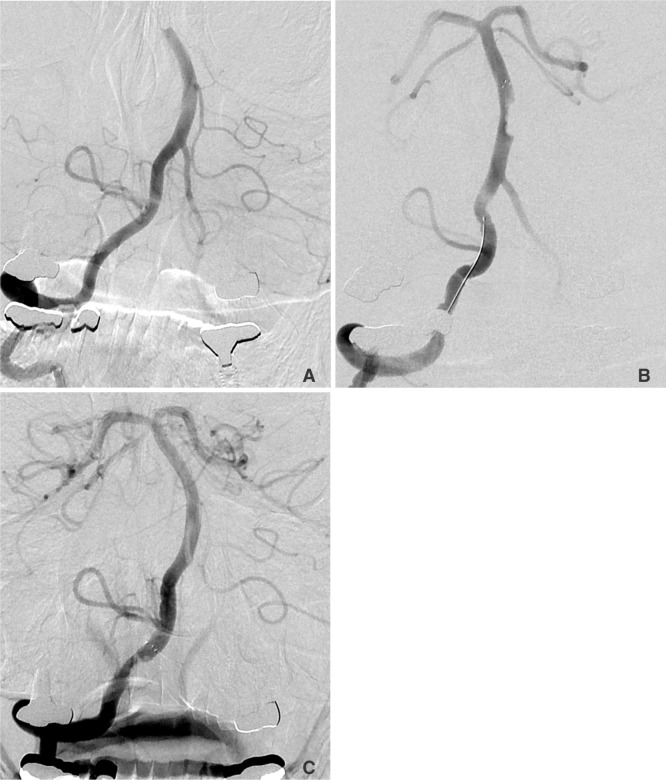Neurointervention.
2014 Feb;9(1):26-31. 10.5469/neuroint.2014.9.1.26.
Mechanical Thrombectomy Using the Solitaire FR system for Occlusion of the Top of the Basilar Artery: Intentional Detachment of the Device after Partial Retrieval
- Affiliations
-
- 1Department of Radiology, Research Institute of Radiology, Asan Medical Center, University of Ulsan College of Medicine, Seoul, Korea. dhlee@amc.seoul.kr
- 2Department of Radiology, Tuen Mun Hospital, Tsing Chung Koon Road, Tuen Mun, New Territories, Hong Kong.
- KMID: 1910771
- DOI: http://doi.org/10.5469/neuroint.2014.9.1.26
Abstract
- Acute, distal, basilar artery occlusion is a challenging neurovascular emergency. There have been several reports regarding the successful application of the Solitaire FR device for treating this lesion. However, due to the lack of a suitable, balloon-tipped, guiding catheter for the vertebral artery, during this procedure we frequently experience the occurrence of clot fragmentation and distal migration. There may be some technical solutions to solve this problem. The purpose of this report is to present a technical variation of using the Solitaire FR, and which is referred to as the 'intentional device detachment technique.' As a clot tends to re-embolize during its passage through the tortuous cranio-cervical junction level of the vertebral artery or its passage through the tip of the guiding catheter, due to the lack of proximal flow arrest, we thought that not removing the stent segment of the device which is capturing the clot could avoid this problem. We were able to successfully apply this technique in two cases. We believe that this technique can be a possible technical option for using the Solitaire FR device when a patient has little concern regarding the subsequent use of antiplatelets.
MeSH Terms
Figure
Reference
-
1. Mourand I, Machi P, Milhaud D, Picot MC, Lobotesis K, Arquizan C, et al. Mechanical thrombectomy with the Solitaire device in acute basilar artery occlusion. J Neurointerv Surg. 2013; 5. 04. [Epub ahead of print].
Article2. Espinosa de Rueda M, Parrilla G, Zamarro J, García-Villalba B, Hernández F, Moreno A. Treatment of acute vertebrobasilar occlusion using thrombectomy with stent retrievers: initial experience with 18 patients. AJNR Am J Neuroradiol. 2013; 34:1044–1048. PMID: 23124642.
Article3. Mordasini P, Brekenfeld C, Byrne JV, Fischer U, Arnold M, Heldner MR, et al. Technical feasibility and application of mechanical thrombectomy with the Solitaire FR Revascularization Device in acute basilar artery occlusion. AJNR Am J Neuroradiol. 2013; 34:159–163. PMID: 22723058.
Article4. Noorian AR, Gupta R, Nogueira RG. Acute stroke: techniques and results with the Merci retriever. Tech Vasc Interv Radiol. 2012; 15:47–52. PMID: 22464302.
Article5. Smith WS, Sung G, Saver J, Budzik R, Duckwiler G, Liebeskind DS, et al. Mechanical thrombectomy for acute ischemic stroke: final results of the Multi MERCI trial. Stroke. 2008; 39:1205–1212. PMID: 18309168.6. Liu W, Kung DK, Mahaney KB, Rossen JD, Jabbour PM, Hasan DM. Anterior-to-posterior circulation approach for mechanical thrombectomy of an acutely occluded basilar artery using the penumbra aspiration system. World Neurosurg. 2012; 77:398. PMID: 22120391.
Article7. Penumbra Pivotal Stroke Trial Investigators. The penumbra pivotal stroke trial: safety and effectiveness of a new generation of mechanical devices for clot removal in intracranial large vessel occlusive disease. Stroke. 2009; 40:2761–2768. PMID: 19590057.
- Full Text Links
- Actions
-
Cited
- CITED
-
- Close
- Share
- Similar articles
-
- Unexpected Detachment of Solitaire Stents during Mechanical Thrombectomy
- Mechanical Solitaire Thrombectomy with Low-Dose Booster Tirofiban Injection
- The Limitations of Thrombectomy with Solitaire(TM) AB as First-line Treatment in Acute Ischemic Stroke: A Single Center Experience
- How to Escape Stentriever Wedging in an Open-cell Carotid Stent during Mechanical Thrombectomy for Tandem Cervical Internal Carotid Artery and Middle Cerebral Artery Occlusion
- Treatment of the Superior Sagittal Sinus Thrombosis with the Mechanical Thrombectomy Using Stent-Retriever Device



